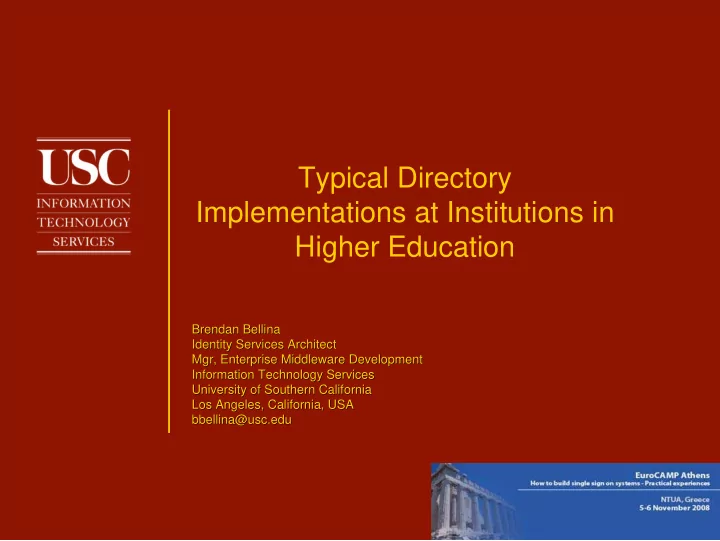

Typical Directory Implementations at Institutions in Higher Education Brendan Bellina Brendan Bellina Identity Services Architect Identity Services Architect Mgr, Enterprise Middleware Development Mgr, Enterprise Middleware Development Information Technology Services Information Technology Services University of Southern California University of Southern California Los Angeles, California, USA Los Angeles, California, USA bbellina@usc. .edu edu bbellina@usc
About the Author Background in Financial Software Development and Data Warehouse Design Active in Higher-Education Identity Management / Directory Services since 2001 Designed and implemented the Enterprise Directory Service at the University of Notre Dame (2001-2004) http://eds.nd.edu Architect of USC Global Directory Service (2005-current) http://www.usc.edu/gds Chair of MACE-Dir Working Group (2008-current) Presentations and online materials available at http://its.usc.edu/~bbellina 2
What Are Directories Used For? A directory is … a specialized database that contains information about an institution’s devices membership roles services systems groups and more! 3
NMI Middleware Diagram QuickTime™ and a TIFF (Uncompressed) decompressor QuickTime™ and a are needed to see this picture. TIFF (Uncompressed) decompressor are needed to see this picture. 4
Enterprise Directory Architectures Centralized EDS Everything queries the central EDS Central control Performance bottleneck risk Replicated EDS Replicate servers for performance Small Risk of Data Latency Derivative directories Distribute EDS data to stand-alone directories Potential issues managing identities Risk of data leakage and inconsistent access controls Risk of Data Latency 5
Directory Products Sun SJES Directory Server Novell eDirectory OpenLDAP Directory Fedora Directory Oracle Internet Directory Microsoft Active Directory 6
Directory Schema 7
Directory Information Tree (DIT) Tall & Spiky Flat ou=Academic ou=People ou=Groups ou=Sciences ou=Arts & Letters ou=Physics ou=Chemistry ou=Philosophy 8
Why not Tall and Spiky? Not amenable to people being in multiple organizational units simultaneously Not efficient when people move between organizational units frequently Not efficient when organizational hierarchy changes occur 9
Distinguished Name Structure (dn) Issues Useful for LDAP enabled apps Visible if any attribute in the entry is visible Must be unique within scope Benefits in being persistent, non-reassignable, and opaque Standards X.500 naming (based on geographical location) cn=Bullwinkle Moose, ou=people, o=Wossamotta U, st=Confusion, c=US Domain Component naming (most commonly used) cn=Bullwinkle Moose, ou=people, dc=Wossamotta, dc=edu 10
Choosing Relative Distinguished Name Initial part of dn, guarantees uniqueness Why not name-based, like cn or uid? Names change - not really owned by directory Facilitates binding directly to entry Possible attack vector Means of authentication without approval or authorization Releases identity if any other attribute is releasable Consider use of opaque identifier owned by directory Exp. uscrdn=usc.edu.scbs5rm6 ,ou=people,dc=usc,dc=edu 11
Standard Object Classes for People person organizationalPerson inetOrgPerson eduPerson SCHAC - SCHema for ACademia eduCourse National object classes - norEdu, plEduPerson, swissEduPerson, etc. See http://middleware.internet2.edu/dir/docs/draft-internet2-mace-dir-higher-ed- person-analysis-latest.htm (last updated 2005) 12
Schema Extensions Step One: Get an OID assignment for your institution from IANA Step Two: Create new objectclasses for new attributes DO NOT make up or reuse an OID DO NOT modify a standard objectclass DO NOT populate standard attributes in non-standard ways 13
Controlling Access 14
Enterprise LDAP Directory Model LDAP-enabled Application LDAP Service accounts System of LDAP System of Record User Info LDAP-enabled Directory System of Record Application Record Groups Because an Enterprise Directory contains all people who use all applications and all their attributes, population and attribute filtering must be done between the application and the directory. LDAP-enabled applications should use assigned LDAP Service accounts to filter based on directory ACI’s. 15
Access Control Instructions/Lists Direct access via LDAP/LDAPS Sun SJES ACI (example @ USC) # Allow all access to the Directory Administrators Group aci: (targetattr ="*") (version 3.0;acl "Directory Administrators Group"; allow (all) (groupdn = "ldap:///cn=Directory Administrators, dc=usc,dc=edu") ; ) # Access to an entry is based on attributes of the entry or group membership of the querying entity. Group membership of the target is not an attribute unless you create one like isMemberOf and populate it. 16
Populations Students Faculty Employees Instructors Affiliates / Guests Alumni Retirees Emeriti 17
Typical Attribute Categories Identifiers Name Contact Information Academic Information Employee Information Affiliation Information Attribute Release Policies Entitlements 18
An Enterprise Directory Service… is a transactional system, read frequently, updated infrequently is not designed to provide reporting or analysis is not a data warehouse is not an alternative to bypass Data Steward oversight is not a source for data to populate local databases and networks 19
Common Services of an EDS White Pages Email client lookup Authentication service Data source for attribute release products such as Shibboleth And sometimes: Authorization / Privileges Group services 20
Links USC: http://www.usc.edu Brendan Bellina, bbellina@usc.edu 21
Recommend
More recommend